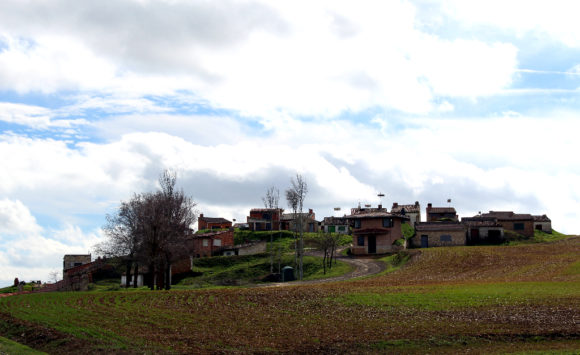Villaherreros
![]()


1.
Iglesia Parroquial de San Román
The Parish Church of San Román is an outstanding example of 14th-century Gothic architecture, consisting of three naves separated by robust pillars supporting groin vaults, while the Baroque plasterwork adds a later decorative touch. Its Romanesque-style doorway dates from the 12th century, and the tower, located at the foot of the temple, was built in 1896 according to the design of the architect E. Marquina.
Inside, in the Gospel nave, there is a painting of the Assumption of the Virgin, a work of the Seville School, accompanied by two altarpieces. One of them, in Baroque style from the 18th century, houses a Crucifix from the 16th century, while the other is a Rococo altarpiece with several sculptures. In the presbytery, the main altarpiece stands out, dating from the second half of the 18th century, with a central sculpture of San Román and an elaborate tabernacle-sagrario, both works attributed to Manuel Álvarez, a disciple of Juan de Juni, whose influence is reflected in several works in the region, such as the cloister of the Monastery of San Zoilo in Carrión de los Condes, the church of San Juan Bautista in Santoyo, and the cathedral of Palencia.
In the Epistle nave there is a Solomonic altarpiece from the second half of the 17th century, together with another altarpiece from the 18th century and a sculpture of San Juan Bautista, as well as several additional artistic pieces. In the Sacristy, there is a splendid 18th-century chest of drawers, decorated with reliefs depicting scenes from the life of San Román. The Casa de la Iglesia houses a 17th-century processional cross, a Renaissance chalice and an impressive silver chest with Mexican enamel from the 16th century, which are displayed during Holy Thursday.

2.
Ermita de Nuestra Señora de Vallarna
The Hermitage of Our Lady of Vallarna houses an 18th-century altarpiece and several sculptures from the same period, including a representation of San Millán, as well as a 16th-century crucifix and a 17th-century painting of the Virgin. This hermitage could be linked to the old church of Santa María, which belonged to the disappeared town of Vallarna.

3.
Ermita de San Millán
The Hermitage of San Millán preserves an altarpiece from the first third of the 17th century, with a sculpture of San Millán, which is one of the most representative elements of the place.

4.
Bodegas de San Pedro
The San Pedro Wineries are located on the top of San Pedro, just over a kilometre from the centre of Villaherreros. This picturesque place, known for its “rich broth”, remains a popular meeting point for both locals and visitors. Today, the wineries have around 100 caves, some of which preserve the old wine presses used for traditional winemaking. In addition, the wineries are a privileged place to enjoy events such as “De tapas por San Pedro”, which is held every July, as well as the pilgrimages that take place during the patron saint festivities.
Access to the wineries is via the Cordel Cerverano, an old path used by the Mesta ranchers, created in the 13th century by Alfonso X El Sabio. The surroundings offer impressive views of the Montaña Palentina and other nearby peaks, such as Espigüete, Curavacas and Las Tuerces, and allow you to see several neighbouring municipalities. In addition, the Provincial Council of Palencia has improved the area with the installation of a picnic area and a viewing point, contributing to the development of this unique space that continues to be a reference point in the social and cultural life of Villaherreros.

